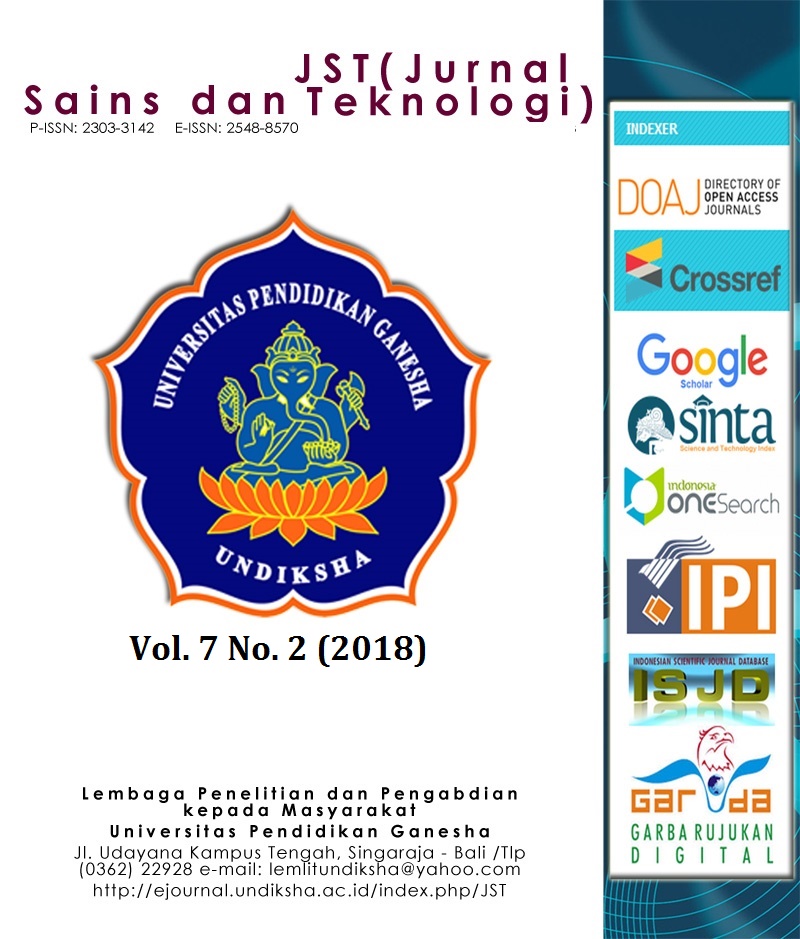Pengembangan Home Automation System (HAS) untuk Mengendalikan Perangkat Listrik Berbasis Bluetooth Menggunakan Aplikasi Android
DOI:
https://doi.org/10.23887/jstundiksha.v7i2.12597Keywords:
Android, bluetooth, remote control, home automationAbstract
Home Automation System (HAS) is a widely used reference term for a system of controlling, monitoring, and home automation functions. HAS generally required a smartphone application or web portal as its interface. The electrical devices can be controlled by a switch, timer, sensor or remote control. In this paper, we describe the module for controlling devices with applications from smartphones via a Bluetooth connection called Android Bluetooth Control Device (ABCD). This module is packaged portable and can be used in classroom learning or demonstrated to people who want to know the working principle of this module. The approach used is controlling 8 devices consisting of 4 lights and 4 additional devices. The module is controlled with smartphone application via Bluetooth using Bluetooth HC-05 which works on 2.4 GHz frequency with a maximum range of 10 m. ABCD module can be used to facilitate the user in controlling various electrical devices at home.References
Demeure, A., Caffiau, S., Elias, E., & Roux, C. (2015). Building and Using Home Automation Systems : A Field Study. ISEUD. https://doi.org/10.1007/978-3-319-18425-8_9
Doran, G. T. (1981). There’s a S.M.A.R.T. way to write managements’s goals and objectives. Management Review, 70(11), 35–36. https://doi.org/10.1177/004057368303900411
Gitakarma, M. S., Indrawan, G., & Adiarta, A. (2016). Pengembangan Modul Android Bluetooth Remote Control Relay sebagai Sistem Otomasi Rumah Tinggal. In Proceeding of Seminar Nasional Riset Inovatif (SENARI) ke-4, Undiksha (pp. 170–177).
Harikrishnan, D., Nikhil, S., Roy, M. T., & Mathew, S. V. (2017). Android Based Home Automation Using Bluetooth. Intl. Journal of Adv. Research in Electrical, Electronics & Instrument. Eng., 6(4), 2605–2609. https://doi.org/10.15662/IJAREEIE.2017.0604073
Pandya, B., Mehta, M., Jain, N., & Kadam, S. (2016). Android Based Home Automation System Using Bluetooth & Voice Command. International Research Journal of Engineering and Technology (IRJET), 03(04), 1337–1342.
Panth, S., & Jivani, M. (2013). Home Automation System (HAS) using Android for Mobile Phone. Intl. Journal of Electronics and Computer, 3(1).
Ramlee, R. A., Othman, M. A., Leong, M. H., Ismail, M. M., & Ranjit, S. S. S. (2013). Smart Home System Using Android Application. In Intl. Conf. of Information and Communication Technology (ICoICT) (pp. 277–280). https://doi.org/https://doi.org/10.1109/ICoICT.2013.6574587
Sriskanthan, N., Tan, F., & Karande, A. (2002). Bluetooth based Home Automation System. Microprocessors and Microsystems, 26(6), 281–289. https://doi.org/10.1016/S0141-9331(02)00039-X
Downloads
Published
How to Cite
Issue
Section
License
Authors who publish with the Jurnal Sains dan Teknologi (JST) agree to the following terms:
- Authors retain copyright and grant the journal the right of first publication with the work simultaneously licensed under a Creative Commons Attribution License (CC BY-SA 4.0) that allows others to share the work with an acknowledgment of the work's authorship and initial publication in this journal.
- Authors are able to enter into separate, additional contractual arrangements for the non-exclusive distribution of the journal's published version of the work (e.g., post it to an institutional repository or publish it in a book), with an acknowledgment of its initial publication in this journal.
- Authors are permitted and encouraged to post their work online (e.g., in institutional repositories or on their website) prior to and during the submission process, as it can lead to productive exchanges, as well as earlier and greater citation of published work. (See The Effect of Open Access)
















